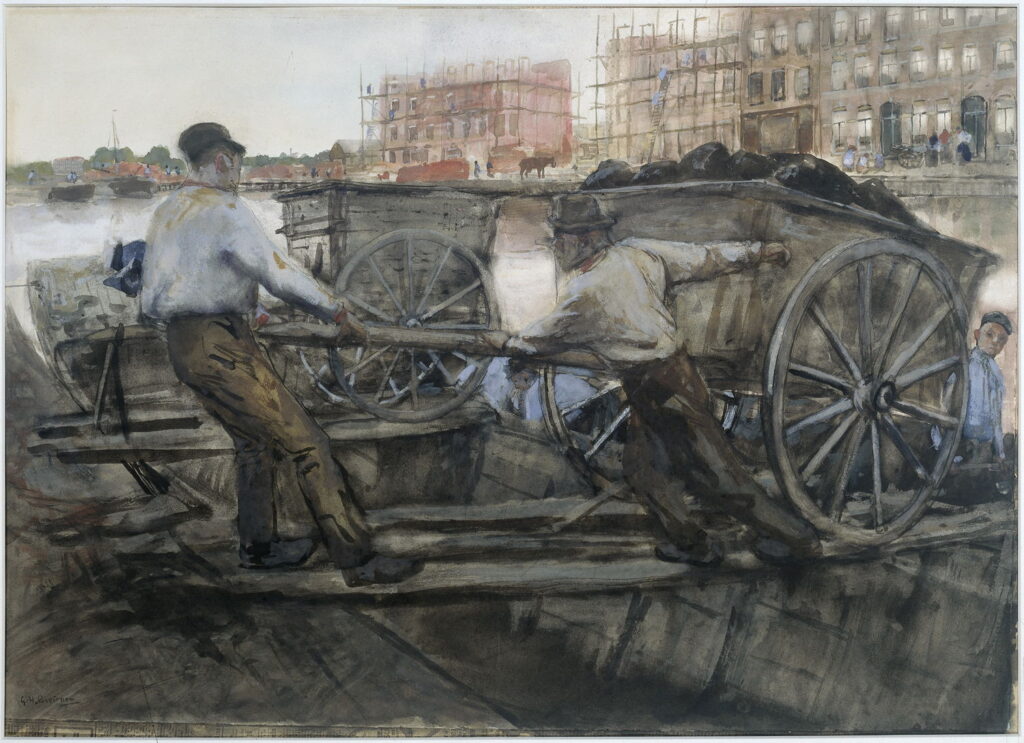Urban Revolutionaries: 4 Coal and construction

The early industrial revolution in Europe used existing forms of power, wind and water, but quickly outgrew their capacity and turned to coal to fuel its growth. The heat generated by burning coal turned water into steam, and steam powered engines to run industrial processes and to move goods, including coal from the mines.
During the eighteenth and nineteenth centuries, coal mining grew greatly in the coalfields that had been discovered across northern Europe. Although some was quarried from open-cast sites, most production came from deep mines. Northern France, Belgium, Germany, Poland, and Britain had an insatiable need for hard-working, fit young men to work as miners in the towns and cities that developed in mining areas. In Britain alone, annual production of coal grew from 3 to 16 million tons between 1700 and 1815, and doubled again by the middle of the nineteenth century.
Constantin Meunier is best known for his gritty paintings of coal mining and foundries in Belgium in the late nineteenth century. He started painting these motifs in 1880, when he was commissioned to paint industrial parts of the country, and continued until his death in 1905. Unfortunately almost all of these paintings are undated.
Constantin Meunier (1831–1905), Mining Area (date not known), oil on canvas, 61.3 x 100.2 cm, M-Museum Leuven, Leuven, Belgium. Wikimedia Commons.
The similarities between Meunier’s Mining Area (above) and Black Country – Borinage (below) suggest that they are the same view, and that above may have been his original plein air sketch. The Borinage was one of the major coal mining areas in Europe at the time, and is in the Belgian province of Hainault. It was here that Vincent van Gogh lived between 1878-80. The tower at the left is the pit head, where trucks of freshly cut coal were brought to the surface.
Constantin Meunier (1831–1905), Black Country – Borinage (date not known), oil on canvas, dimensions not known, Meunier Museum, Brussels, Belgium. Image by Szilas, via Wikimedia Commons.
Constantin Meunier (1831–1905), Miner at the Exit of the Shaft (date not known), oil on canvas, dimensions not known, Meunier Museum, Brussels, Belgium. Image by Szilas, via Wikimedia Commons.
Meunier’s painting of Miner at the Exit of the Shaft shows several miners enjoying a few moments to smoke and relax at the pit head. Three are carrying safety lamps, used to minimise the risk of underground explosions even though they had flames inside them. These were developed in about 1815, after a long succession of mine disasters caused by explosions, and weren’t replaced by electric lamps until after 1900.
Constantin Meunier (1831–1905), Return from the Mine (date not known), oil on canvas, 159 x 115 cm, M-Museum Leuven, Leuven, Belgium. Image by Ophelia2, via Wikimedia Commons.
In his Return from the Mine, two male miners stride back to their cottages after completing their shift underground. With them is a young woman, employed to perform supporting tasks, who is walking barefoot and holding up her wooden clogs.
Constantin Meunier (1831–1905), The Carriage Driver (1887), media and dimensions not known, Museum Dhondt-Dhaenens, Sint-Martens-Latem, Belgium. Wikimedia Commons.
Painted in 1887, The Carriage Driver shows another working woman, taking a short break from her duties. She appears to be sat by the pit head, and has a safety lamp by her left leg, making it likely that she too is in one of the mining areas.
Constantin Meunier (1831–1905), Les Hiercheuses (c 1885-90), oil on canvas, 66.5 x 50.5 cm, Private collection. Wikimedia Commons.
One task largely performed by women was the movement of wagons containing coal or spoil (general rock debris). These two young women, termed Les Hiercheuses, did just that, and were painted by Meunier in about 1885-90.
Constantin Meunier (1831–1905), Triptych of the Mine (Descent, Calvary, Ascent) (date not known), oil on canvas, dimensions not known, Meunier Museum, Brussels, Belgium. Image by Szilas, via Wikimedia Commons.
Meunier also made monumental reliefs and sculptures to commemorate the miners, and this Triptych of the Mine, showing their Descent, Calvary, and Ascent, to parallel the Crucifixion.
Until its mechanisation in the twentieth century, coal mining was almost entirely manual. It also had one of the highest risks of death or injury at work. Those who survived the immediate physical dangers rarely lived long, as a result of destructive lung disease (pneumoconiosis) from inhaling dust when working underground.
As urban areas grew and were remodelled during the nineteenth century, demand for construction workers increased. Many of those who were drawn from the country found employment as labourers, and some were able to undertake more skilled jobs as carpenters. Several painters of the period showed insights into the working conditions in this industry, including George Hendrik Breitner who painted views of Amsterdam during its expansion late that century.
George Hendrik Breitner (1857–1923), Ground Porters with Carts (date not known), watercolour on paper, 67.5 × 93.4 cm, Rijksmuseum Amsterdam, Amsterdam, The Netherlands. Wikimedia Commons.
Breitner captured this in his undated watercolour sketch of Ground Porters with Carts. These were the jobs that immigrants from the country were often employed in, as physically demanding and dirty as their previous work on the land.
George Hendrik Breitner (1857–1923), Building Site in Amsterdam (after 1880), oil on canvas, 52 × 91 cm, Rijksmuseum Amsterdam, Amsterdam, The Netherlands. Wikimedia Commons.
Building Site in Amsterdam is another of Breitner’s sketches of construction work, this time painted in oils.
In Paris, it was Maximilien Luce who painted some of the best insights into the rebuilding of parts of the city in the early years of the twentieth century.
Maximilien Luce (1858–1941), The Pile Drivers (1902-3), oil on canvas, 153 x 195 cm, Musée d’Orsay, Paris. Wikimedia Commons.
The Pile Drivers (1902-3) is one of Maximilien Luce’s explorations of the working life of the common man in Paris. These labourers are pulling on the rope to drive piles into the foundation of buildings on the banks of the River Seine. Although piles could also be driven by steam power, it was often cheaper and quicker to use labourers instead.
Maximilien Luce (1858–1941), Construction Site (1911), oil on canvas, 73 x 60 cm, Musée d’Orsay, Paris. Wikimedia Commons.
Luce’s Construction Site from 1911 shows the intense human involvement in the urban cycle of demolition and rebuilding.
This period also brought some vast works of civil engineering, such as the construction of the ship canal between Liverpool and Manchester in England.
Benjamin Williams Leader (1831–1923), The Excavation of the Manchester Ship Canal: Eastham Cutting with Mount Manisty in the distance (1891), oil on canvas, 124.5 x 212.1 cm, National Trust, England. Wikimedia Commons.
The Excavation of the Manchester Ship Canal: Eastham Cutting with Mount Manisty in the distance (1891) is one of a series Benjamin Williams Leader painted showing the fruits of his brother’s engineering labours. This major canal was constructed between 1887 and 1893, and carries ocean-going ships from the estuary of the River Mersey near Liverpool 36 miles (58 km) into the heart of Manchester, in the industrial north of England. This view is set close to the seaward entrance, and shows steam diggers and railways being used to excavate and remove the spoil, some of which is building Mount Manisty to the left of centre. The canal remains in use, and is currently being further improved.
Many of those working in these industries increasingly felt exploited in the late nineteenth century, leading to social unrest and strikes, as I’ll show in the next article in this series.



